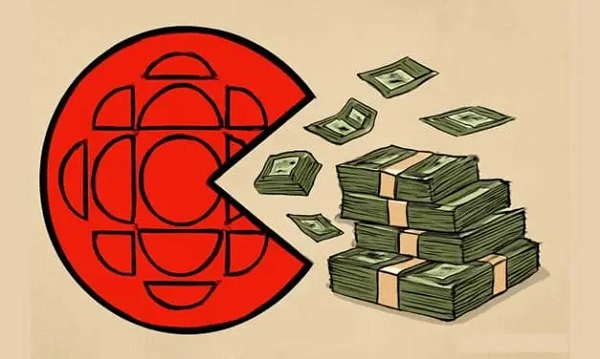Business
Growing the government won’t help Canada’s economy

From the Fraser Institute
By Jake Fuss and Grady Munro and Alex Whalen
Empirical research suggests that economic growth is maximized when the size of government falls between 24 and 32 per cent of GDP. In other words, when governments spend in excess of this range, the economy will not grow as much as it would if government operated within that threshold
Canada is suffering from an economic growth crisis, and governments across the country should reassess their policies. Governments (particularly the federal government) have recently taken a more active role in the economy through increased spending and bureaucracy. However, policymakers must take a step back and recognize that growing government doesn’t lead to growth in the economy.
Canada’s economy has been stagnant for the last decade. From 2013 to 2022, per-person GDP (a broad measure of living standards) grew at its slowest pace since the 1930s, after accounting for inflation. And more recent data shows that in the fourth quarter of 2023, per-person GDP (inflation-adjusted) stood at $58,111—which is $51 per person lower than it was at the end of 2014. Simply put, Canadians have experienced a decade of dismal growth, and are now actually worse off than they were a decade ago.
During this time, many governments in Canada have adopted an approach of greater involvement in the economy and significantly higher spending. Take the federal government, for example.
Since 2014/15, the government has increased annual program spending (total spending minus debt interest) by roughly 75 per cent, from $256.3 billion to $448.2 billion in 2022/23. Moreover, the Trudeau government has recorded the five-highest years of federal spending in Canadian history, after accounting for population growth and inflation. Much of this spending has gone towards expanding Ottawa’s role in the economy through increased transfers, business subsidies or new programs such as $10-a-day daycare and national dental care.
Provincial governments in Quebec, Nova Scotia and British Columbia (to name a few) have also recently reached historical highs in per-person program spending (even after excluding COVID-related spending). Simply put, governments across the country have been increasing spending and becoming more involved in the economy.
One way to measure the size of government, that allows for the comparison of jurisdictions over time, is known as total consolidated government spending as a share of GDP. This measure includes all spending at the local, provincial and federal levels in a jurisdiction and compares that level to the size of the economy.

According to a recent study, in 2022 (the latest year of available data) the size of government in Canada was 40.5 per cent of GDP compared to 38.2 per cent in 2014.
Among the provinces, total government spending ranged from 26.8 per cent of GDP in Alberta to 63.0 per cent of GDP in Nova Scotia. Compared to 2014, the size of government grew in eight of 10 provinces—only Prince Edward Island and B.C. experienced declines in government spending as a share of the economy. It’s also important to note that this is simply government spending. The true size of government, when accounting for things like regulation, is even larger.
Growing government matters because it influences economic growth. When the size of government is below a certain level, it lacks the resources to deliver services such as policing, courts or national defence—which are essential to a functioning economy. On the other hand, when government is too big it engages in activities best left to the free market and effectively crowds-out private-sector activity that contributes to economic growth. Therefore, when a government is too small or too big, economic growth (and consequently living standards) suffer.
Empirical research suggests that economic growth is maximized when the size of government falls between 24 and 32 per cent of GDP. In other words, when governments spend in excess of this range, the economy will not grow as much as it would if government operated within that threshold—all else equal. Based on the numbers presented above, it’s clear the vast majority of governments in Canada are too big. For nine of 10 provinces and the federal government, their spending exceeded 32 per cent of GDP in 2022.
As Canadians look for solutions to address a stagnating economy and falling living standards, governments should recognize that taking a more active role in the economy won’t solve the problem—and will likely make it worse.
Authors:
Business
Rhetoric—not evidence—continues to dominate climate debate and policy

From the Fraser Institute
Myths, fallacies and ideological rhetoric continue to dominate the climate policy discussion, leading to costly and ineffective government policies,
according to a new study published today by the Fraser Institute, an independent, nonpartisan Canadian public policy think-tank.
“When considering climate policies, it’s important to understand what the science and analysis actually show instead of what the climate alarmists believe to be true,” said Kenneth P. Green, Fraser Institute senior fellow and author of Four Climate Fallacies.
The study dispels several myths about climate change and popular—but ineffective—emission reduction policies, specifically:
• Capitalism causes climate change: In fact, according to several environment/climate indices and the Fraser Institute’s annual Economic Freedom of the World Index, the more economically free a country is, the more effective it is at protecting its environment and combatting climate change.
• Even small-emitting countries can do their part to fight climate change: Even if Canada reduced its greenhouse gas emissions to zero, there would be
little to no measurable impact in global emissions, and it distracts people from the main drivers of emissions, which are China, India and the developing
world.
• Vehicle electrification will reduce climate risk and clean the air: Research has shown that while EVs can reduce GHG emissions when powered with
low-GHG energy, they often are not, and further, have offsetting environmental harms, reducing net environmental/climate benefits.
• Carbon capture and storage is a viable strategy to combat climate change: While effective at a small scale, the benefits of carbon capture and
storage to reduce global greenhouse gas emissions on a massive scale are limited and questionable.
“Citizens and their governments around the world need to be guided by scientific evidence when it comes to what climate policies make the most sense,” Green said.
“Unfortunately, the climate policy debate is too often dominated by myths, fallacies and false claims by activists and alarmists, with costly and ineffective results.”

Kenneth P. Green
Senior Fellow, Fraser Institute
Business
Canada’s economic pain could be a blessing in disguise

This article supplied by Troy Media.
 By Roslyn Kunin
By Roslyn Kunin
Tariffs, inflation, and falling incomes sound bad, but what if they’re forcing us to finally fix what’s broken?
Canada is facing serious economic headwinds—from falling incomes to rising inflation and U.S. trade hostility—but within this turmoil lies an opportunity. If we respond wisely, this crisis could become a turning point, forcing long-overdue reforms and helping us build a stronger, more independent economy.
Rather than reacting out of frustration, we can use these challenges to reassess what’s holding us back and move forward with practical solutions. From
trade policy to labour shortages and energy development, there are encouraging shifts already underway if we stay focused.
A key principle when under pressure is not to make things worse for ourselves. U.S. tariffs on Canadian steel and aluminum, and the chaotic renegotiation of NAFTA/CUSMA, certainly hurt our trade-dependent economy. But retaliatory tariffs don’t work in our favour. Canadian imports make
up a tiny fraction of the U.S. economy, so countermeasures barely register there, while Canadian consumers end up paying more. The federal government’s own countertariffs on items like orange juice and whisky raised costs here without changing American policy.
Fortunately, more Canadians are starting to realize this. Some provinces have reversed bans on U.S. goods. Saskatchewan, for example, recently lifted
restrictions on American alcohol. These decisions reflect a growing recognition that retaliating out of pride often means punishing ourselves.
More constructively, Canada is finally doing what should have happened long ago: diversifying trade. We’ve put too many economic eggs in one
basket, relying on an unpredictable U.S. market. Now, governments and businesses are looking for buyers elsewhere, an essential step toward greater stability.
At the same time, we’re starting to confront domestic barriers that have held us back. For years, it’s been easier for Canadian businesses to trade with the U.S. than to ship goods across provincial borders. These outdated restrictions—whether on wine, trucks or energy—have fractured our internal market. Now, federal and provincial governments are finally taking steps to create a unified national economy.
Labour shortages are another constraint limiting growth. Many Canadian businesses can’t find the skilled workers they need. But here, too, global shifts
are opening doors. The U.S.’s harsh immigration and research policies are pushing talent elsewhere, and Canada is emerging as the preferred alternative.
Scientists, engineers and graduate students, especially in tech and clean energy, are increasingly choosing Canada over the U.S. due to visa uncertainty and political instability. Our universities are already benefiting. If we continue to welcome international students and skilled professionals, we’ll gain a long-term advantage.
Just as global talent is rethinking where to invest their future, Canada has a chance to reassert leadership in one of its foundational industries: energy.
The federal government is now adopting a more balanced climate policy, shifting away from blanket opposition to carbon-based energy and focusing instead on practical innovation. Technologies such as carbon capture and storage are reducing emissions and helping clean up so-called dirty oil. These cleaner energy products are in demand globally.
To seize that opportunity, we need infrastructure: pipelines, refining capacity and delivery systems to get Canadian energy to world markets and across our own country. Projects like the Trans Mountain pipeline expansion, along with east-west grid connections and expanded refining, are critical to reducing dependence on U.S. imports and unlocking Canada’s full potential.
Perhaps the most crucial silver lining of all is a renewed awareness of the value of this country. As we approach July 1, more Canadians are recognizing how fortunate we are. Watching the fragility of democracy in the U.S., and confronting the uncomfortable idea of being reduced to a 51st state, has reminded us that Canada matters. Not just to us, but to the world.
Dr. Roslyn Kunin is a respected Canadian economist known for her extensive work in economic forecasting, public policy, and labour market analysis. She has held various prominent roles, including serving as the regional director for the federal government’s Department of Employment and Immigration in British Columbia and Yukon and as an adjunct professor at the University of British Columbia. Dr. Kunin is also recognized for her contributions to economic development, particularly in Western Canada.
Troy Media empowers Canadian community news outlets by providing independent, insightful analysis and commentary. Our mission is to support local media in helping Canadians stay informed and engaged by delivering reliable content that strengthens community connections and deepens understanding across the country.
-

 Energy2 days ago
Energy2 days agoKananaskis G7 meeting the right setting for U.S. and Canada to reassert energy ties
-

 Business2 days ago
Business2 days agoCarney’s Honeymoon Phase Enters a ‘Make-or-Break’ Week
-

 Aristotle Foundation2 days ago
Aristotle Foundation2 days agoThe Canadian Medical Association’s inexplicable stance on pediatric gender medicine
-

 Alberta2 days ago
Alberta2 days agoAlberta announces citizens will have to pay for their COVID shots
-

 conflict2 days ago
conflict2 days agoIsrael bombs Iranian state TV while live on air
-

 Business2 days ago
Business2 days agoCarney praises Trump’s world ‘leadership’ at G7 meeting in Canada
-

 Business1 day ago
Business1 day agoThe CBC is a government-funded giant no one watches
-

 conflict1 day ago
conflict1 day agoTrump leaves G7 early after urging evacuation of Tehran






